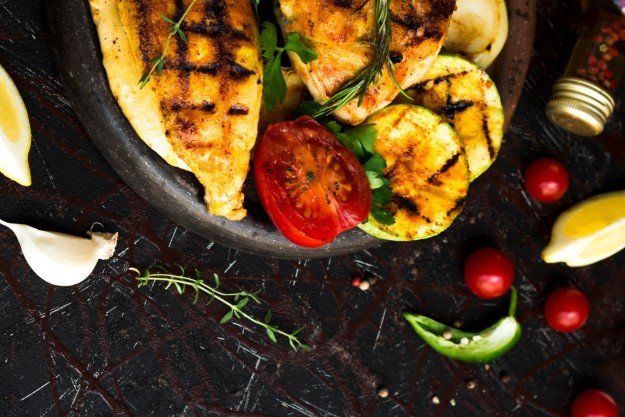Menu


John Robbins is the founder of EarthSave, an international non-profit organisation that promotes healthy and environmentally-sound food choices.
In his books, Diet for a New America and May All Be Fed: Diet for a New World, John Robbins argues that less meat is, put simply, better.
While the benefits of a vegetarian diet for the environment are multifold, this newsletter will be focusing on the benefits for the human body.
Read on to find out why cutting meat out of your diet might be the best choice you can make.“Nothing will benefit human health and increase the chances for survival of life on Earth as much as the evolution to a vegetarian diet.”
– Albert Einstein
Cardiovascular disease, including heart disease, is a major killer in Australia. In fact, according to The Heart Foundation, cardiovascular disease kills one Australian every 12 minutes. Furthermore, almost 2 in 3 Australian adults are overweight.
One of the reasons for this is that in the typical Australian diet, 12% of the average caloric intake comes from saturated fat (including trans fatty acids). This is above the recommended maximum of 10%.
The leading sources of saturated fat and cholesterol are provided by meat, poultry and dairy products. Meat in particular has a tremendous amount of fat and cholesterol. Meanwhile, diets consisting of fruits, grains, legumes, vegetables, nuts and seeds have no harmful cholesterol.There is now convincing scientific evidence that eating processed and red meats increases the risk of developing bowel cancer. In fact, the World Cancer Research Fund (WCRF) has recommended that people – especially children – avoid eating processed meat.
Women who eat meat daily have a 3.8 times higher risk of breast cancer than women who eat meat less than once a week.
Men who consume meat, dairy products, and eggs, daily are at a 3.6 times higher risk of developing prostate cancer.Many of us have beliefs about our diets which are not backed by scientific evidence. Instead, they are formed by cultural conditioning. Media plays a very big part in this.
And yet, when we look through history, we can see that higher rates of heart disease and cancer come in right at the moment when humans started eating more dairy and meat.
The documentary, Food, Inc. looks into the marketing of dairy and meat into our daily diets, and the resulting impact on daily life.
Don’t I need to eat meat for energy?
No. If you look back on our newsletter regarding aerobic and anaerobic exercise, you’ll remember that protein is actually the last thing the body burns for energy. The body first burns sugar, and then carbohydrates. The body only burns protein when it has exhausted all other fuel sources. It is a last resort. Plus, excess protein creates nitrogen. This, in turn, causes fatigue.
Don’t I need to eat meat to have strong bones?
Actually, people who eat meat tend to have the weakest bones. This is because meat contains a lot of uric acid, and leeches calcium from the body.
Are there times in my life when I will need to eat more protein?
Yes, when you’re an infant! 1.2-1.6% of mother’s milk is composed of protein. This is actually about the same amount as many fruits. As you get older, protein becomes less critical for your body. Research shows that 16-23 grams of protein in your diet is more than enough for most cultures around the world.
What is the role of uric acid in the taste of meat?
As the name suggests, uric acid is the acid in urine. It is this acid that gives meat its taste. The average piece of meat weighing 85-113 grams contains about 16 grains of uric acid.
Unfortunately, your body can only handle about 8 grains of uric acid a day. Furthermore, uric acid in the bloodstreams contributes to arthritis by irritating the tendons and joints.
What do putrefactive bacteria have to do with the taste of meat?
Putrefactive bacteria are the bacteria that are found in the colon. When an animal dies, these bacteria cover all the cells of the meat. This helps the body decompose. It is also these putrefactive germs that tenderise the meat.
Are there any famous vegetarians?
There have been many famous vegetarians throughout history. For example: Leonardo da Vinci, Pythagoras, Socrates, Plato, Benjamin Franklin, Benjamin Disraeli, Thomas Edison, Mohatma Gandhi, Albert Einstein, Jane Goodall, and Barack Obama.
And of course, there is Rich Roll, one of the biggest professional athletes on earth. He is pure vegan.
Leonardo da Vinci
Pythagoras
Socrates
Plato
Benjamin Franklin
Benjamin Disraeli
Thomas Edison
Mohatma Gandhi
Albert Einstein
Barack Obama
Jane Goodall
Rich Roll
It can be hard to cut meat out of your diet entirely. Thankfully, there are huge benefits to just eating less of it. If you’re having a hard time cutting meat out of your diet, there are three things you can do so you can still stay healthy. First, get a clean meat source. This can mean kosher meat, range fed, etc. Then, make sure to only eat meat once a day – maximum! Ideally, you will only eat meat during the day, so it doesn’t put pressure on your body while you sleep. And finally, make sure to properly combine your food for maximum nutrition.
We hope you liked learning about the dangers of meat. Remember: at Whistle Clean Australia, we care about your health.
If you have any friends, family or associates who are looking for commercial or office cleaning, we would be delighted to assist them.
We are passionate about helping businesses stay clean and healthy, so please pass on our details. Or alternatively, please provide us with their details and we will contact them directly.
Photo credits: freepik.com